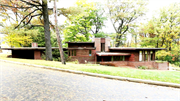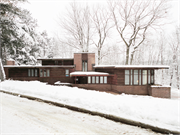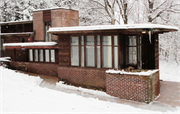Property Record
1224 HIGHLAND PARK BLVD
Architecture and History Inventory
| Historic Name: | Charles L. and Dorothy Manson House |
|---|---|
| Other Name: | |
| Contributing: | Yes |
| Reference Number: | 29249 |
| Location (Address): | 1224 HIGHLAND PARK BLVD |
|---|---|
| County: | Marathon |
| City: | Wausau |
| Township/Village: | |
| Unincorporated Community: | |
| Town: | |
| Range: | |
| Direction: | |
| Section: | |
| Quarter Section: | |
| Quarter/Quarter Section: |
| Year Built: | 1941 |
|---|---|
| Additions: | |
| Survey Date: | 1983 |
| Historic Use: | house |
| Architectural Style: | Usonian |
| Structural System: | |
| Wall Material: | Brick |
| Architect: | Frank Lloyd Wright |
| Other Buildings On Site: | |
| Demolished?: | No |
| Demolished Date: |
| National/State Register Listing Name: | Manson, Charles L. and Dorothy, House |
|---|---|
| National Register Listing Date: | 4/5/2016 |
| State Register Listing Date: | 11/20/2015 |
| National Register Multiple Property Name: | |
| National/State Register Listing Name: | Highland Park Historic District |
| National Register Listing Date: | 10/17/2022 |
| State Register Listing Date: | 2/18/2022 |
| National Register Multiple Property Name: |
| Additional Information: | A 'site file' exists for this property. It contains additional information such as correspondence, newspaper clippings, or historical information. It is a public record and may be viewed in person at the State Historical Society, Division of Historic Preservation. This house is also a Local Landmark for the City of Wausau. Construction Dates: 1939-1941. As soon as Charles Manson, owner of a local insurance company, read about the first house Wright had created for Herbert and Katherine Jacobs in Madison, he knew he wanted a Wright design of his own. It became the fourth of Wright’s Usonian houses. The exterior materials are characteristic of Wright in this period: red brick for the central core and lower walls, cypress-wood siding and generous expanses of glass for the rest. The exterior wood walls and interior partitions employ the architect’s usual plywood core sandwiched between cypress board-and-batten layers on both the inner and outer faces. Here, however, to adjust the house to Wausau’s frigid winters, Wright called for three layers of plywood rather than the typical one layer. He also responded to the sloping lot by designing the house to step down three levels from west to east. This composition, combined with a low second story and a tall brick core, creates a sprawling, multilayered appearance. Nonetheless, because of its long horizontal lines and flat, wide-overhanging roof, the house still seems grounded to the earth. The Manson House plan reflects a Wrightian experiment in design geometry. This design combines squares with triangles and parallelograms. Consequently, the living room on the east end and the master bedroom and carport (now enclosed) on the west, are oddly shaped by 30- and 60-degree angles. These rooms are joined along a diagonal axis that runs west to east. The circulation pattern is strange, too: Wright placed the main entrance next to the carport at the west end of the diagonal, at the opposite end from the living room. Visitors step down from the entry into the bedroom wing and walk east along a long lengthy hallway, through the normally private section of a house, to reach the main public areas. At the far end of this hallway, the visitor descends into the sunken living room, a classic Wrightian space with a high ceiling, massive brick fireplace, and glazed doors opening onto a terrace. Wright designed many special features into the house, including a built-in phonograph system in the living room and a laundry rack in the two-story-tall kitchen. To dry laundry, the Mansons lowered the wooden rack, hung wet clothes on it, then lifted it to a position high above the kitchen by pulling a rope attached to a pulley. Upstairs, extending west from the workspace tower is a maid’s room and a darkroom for Charles, an amateur photographer. These upstairs rooms constitute a full-height upper story, but from the outside this story appears to rise only a few feet above the bedroom wing--a low profile made possible by dropping the ceilings of the children’s bedrooms underneath. |
|---|---|
| Bibliographic References: | "NEWS FOR FRIENDS" 9/93. FRIENDS OF WAUSAU HISTORIC LANDMARKS NEWSLETTER, JULY-AUGUST 1994, P. 9. WAUSAU DAILY HERALD 6/28/1995. ANDREW WARREN HISTORIC DISTRICT, FRIENDS OF WAUSAU HISTORIC LANDMARKS, 1995(?). Buildings of Wisconsin manuscript. City in the Pinery, A Guide to Wausau's Historic Architecture, The City of Wausau, 1983. City in the Pinery, A Guide to Wausau's Historic Architecture, The City of Wausau, 1984. https://davdwood.wixsite.com/manson/ |
| Wisconsin Architecture and History Inventory, State Historic Preservation Office, Wisconsin Historical Society, Madison, Wisconsin |





